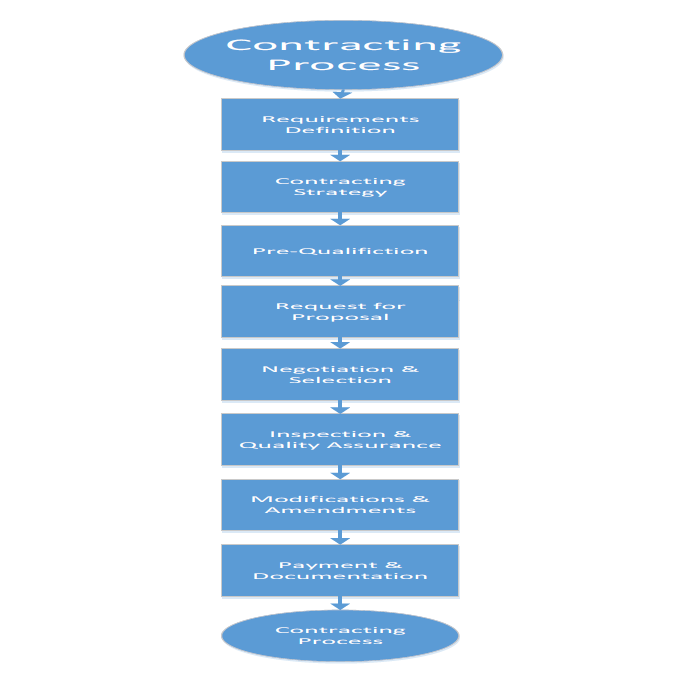8.2: Contract Management
- Page ID
- 21153
Contracting with outside organizations to perform infrastructure management tasks is both common and useful. Contracting has several advantages relative to performing all tasks within the infrastructure owner organization:
- Can provide more resources for peak work period demands. For example, major rehabilitation projects require significant resources of equipment and manpower which are typically beyond the regular resources in an ongoing infrastructure management organization. As a result, rehabilitation work is usually contracted out.
- Can provide access to specialized knowledge and equipment. Outside organizations can specialize in a particular area such as elevator or roof inspection, for which expertise is not needed year-round for the infrastructure management organization. Similarly, road repaving is generally contracted out rather than maintaining specialized paving equipment in a municipality.
At the same time, contracting incurs costs for contact management and payments of profits to contractors.
Contracts come in a bewildering variety of forms. They can have many different payment terms and risk allocation provisions (Hendrickson, 2007). They typically vary between countries, organizations, and types of work. They are also subject to complex legal forms and reviews. By and large, actual contract documents are prepared by a legal department or a professional organization and contract provisions are re-used extensively, so individual infrastructure managers do not need to draft new contract documents.
The important stages in contracting are shown in Figure 8.1 and discussed briefly below. Not all of these stages will occur in every contracting process. For example, contract modifications may not be required in many cases.
- Requirements definition is a process to specify the work desired from the contractor. For a major rehabilitation project, this definition may require a significant component design process.
- Contracting strategy formulation is a series of decisions about the contracting process, such as pricing and time frame requirements.
- Pre-Qualification is a process of selecting a group of potential contractors. Pre-qualification may be a subjective judgment by a manager or maybe a formal process of application and qualification reviews. In many cases, infrastructure managers may have long term relationships with contractors and build up confidence and trust in their capabilities.
- Request for a quote or proposal from potential contractors. The request will usually include pricing parameters and the desired time frame for the work. Pricing options include fixed price, cost plus profit, guaranteed maximum price, and unit cost. Unit cost pricing is useful for ongoing contracts with numerous tasks. For example, a unit cost pricing for roadway repaving might have a price per lane-mile of repaving.
- Negotiation and selection of a contractor can take many forms. A classic, competitive fixed bid approach receives monetary bids from pre-qualified contractors and awards the work on the basis of lowest costs. The infrastructure manager may also negotiate terms with multiple potential contractors and eventually award the contract to the most desirable terms.
- Inspection and Quality Assurance is a post-award task to insure that the work is done to the desired requirements.
- Contract modification is a common process. During the course of work, the desired requirements may change or unforeseen circumstances dictate different approaches. Contractors will typically be willing to negotiate contract modifications in response.
- Payments and reporting are processes that make periodic and final payments to contractors as well as documenting the entire process.

Allocation of risks between contractors, owners and other interest parties is an important issue in contracting. Risk allocation becomes important whenever unexpected events occur. For example, the required work may be more extensive than originally expected and then the question arises: who will pay for the extra work? A partial list of responsibilities with concomitant risk that can be assigned to different parties would include (Hendrickson, 2007):
- Force majeure (i.e., this provision absolves an owner or a contractor for payment for costs due to "Acts of God" and other external events such as war or labor strikes).
- Indemnification (i.e., this provision absolves the indemnified party from any payment for losses and damages incurred by a third party such as adjacent property owners.).
- Liens (i.e., assurances that third party claims are settled such as "mechanics liens" for worker wages).
- Labor laws (i.e., payments for any violation of labor laws and regulations on the job site).
- Differing site conditions (i.e., responsibility for extra costs due to unexpected site conditions).
- Delays and extensions of time.
- Liquidated damages (i.e., payments for any facility defects with payment amounts agreed to in advance).
- Consequential damages (i.e., payments for actual damage costs assessed upon impact of facility defects).
- Occupational safety and health of workers, including insurance provisions and payments in the event of safety damages.
- Permits, licenses, laws, and regulations. It is often difficult to know exactly what permits may be required.
- Equal employment opportunity regulations.
- Termination for default by contractor.
- Suspension of work.
- Warranties and guarantees.


